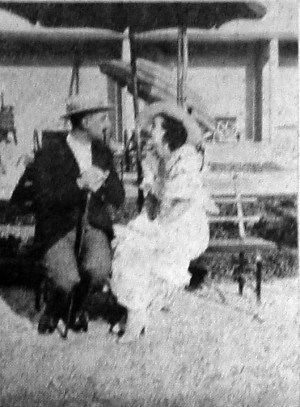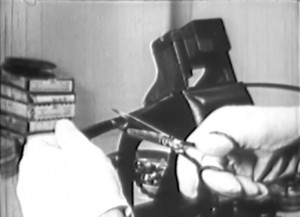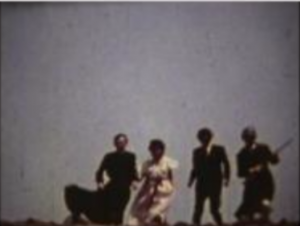
"avant-garde documentary"
"Fiera di tipi, realizzata da Leone Viola con la collaborazione tecnica di Fernando de Marzi, si svolge tutta sullo sfondo della Fiera di Padova ed ha una trama impostata su ben sette personaggi di primo piano. Ma i realizzatori hanno saputo imprimere a ciascuno di essi una fisonomia inconfondibile creando anche due gustose macchiette: ma i caratteri non sono caricati: la vicenda scorre dall'uno all'altro dei personaggi, si imbroglia, si ricompone: la Fiera di Padova è di sfondo all-azione che senza fiera non esisterebbe; tanto tutti gli episodi sono strettamente connessi a quella manifestazione. La fotografia, dovuta a Dodi Calcagno, è in qualche punto un po' oscura, altrove assume un brillante risalto. Le doti narrative dei realizzatori si manifestano in questo film della durata di un'ora, ed è intanto — a parte gli altri pregi del film—non poco. Qualche lieve ritocco al montaggio si renderebbe necessario, allo scopo di raggiungere una completa omogeneità narrrativa. Noi parlando nel nostro passato numero prevedevamo il successo che questo film ha ottenuto, che sarà di incoraggiamento ai giovani volenterosi."
"Fiera di tipi, directed by Leone Viola with the technical collaboration of Fernando de Marzi, takes place against the backdrop of the Padua Fair and has a plot based on seven leading characters. But the creators were able to give each of them an unmistakable physiognomy, also creating two tasty little characters: but the characters are not privileged: the story flows from one character to the other, is cheated, is recomposed: the Fair of Padova is the background to the action that would not exist without the fair; all the episodes are closely related to that event. The photography, by Dodi Calcagno, is at some points a little obscure, elsewhere it takes on a brilliant prominence. The narrative talents of the filmmakers are manifested in this one-hour film, and is meanwhile - apart from the other merits of the film - not insignificant. A few slight adjustments to the editing would be necessary in order to achieve complete narrative homogeneity. We, speaking of it in our past issue, predicted the success this film has achieved, which will be an encouragement to willing young people."
From "Gazzetta di Venezia" republished in "Cine-club Padova," Eco del cinema, n. 130, 1934
"Vincente Mills, of Manila, Philippines, for his entry in the American Cinematographer 1933 competition will make a religious picture built around the practice in his country which takes place during Holy Thursday and Good Friday each year. As this practice is fast disappearing, according to Mills, it will also act as a fine historic record." American Cinematographer, Sept. 1933, 191.

"Film Editing, an exposition of this topic, is a single subject in the series, You Can Make Good Movies, produced by the Harmon Foundation of New York and photographed by Kenneth F. Space. This film presents the successful use of a medium to explain its own working and is divided into two parts — first, the mechanical operations involved in editing and splicing and, second, the methods used to present simple cinematic ideas through cutting. The clear and well ordered presentation of this subject is noteworthy. The first part of the film is characterized by a number of excellent, unusually large closeups showing the operations of scraping the film, applying cement, splicing, etc. In one or two of these closeups, however, the significant action was partially obscured, as in the case of closeups showing the application of cement to a splice, where the cork at the end of the brush got in the way. In general, however, the presentation was very clear and well photographed. Other methods than those shown could have been employed to produce the same results, but, in an instructional film of this nature, it is taken for granted that only one method can be presented without confusion." Movie Makers, Dec. 1939, 636.
"The most stylistically experimental film among Kaneko’s works but also one of the most self-reflexive Japanese films of the interwar period. In this film, Kaneko featured the process of 9.5mm filmmaking by means of visual experiments and abstraction. By constructing the film in a way to trace the process of shooting, self-developing, editing, and projecting a film, he manipulated montage and multiple exposures as well as the use of light and shadow, while he elaborated the use of close-up shots that captured film devices and the filmmaker (presumably Kaneko himself) at work... Many advanced amateurs considered the process of filmmaking as an essential part of defining the idea of amateurishness. Unlike commercial productions that involved many casts and crews, amateur productions had the privilege of creating a work individually by going through the entire process of filmmaking, which allows the filmmaker to make every decision on his or her own. Kaneko’s Film Study 9 1/2 visualized this process by reflecting his artistic sensibilities." - Noriko Morisue, "Filming the Everyday: History, Theory, and Aesthetics of Amateur Cinema in Interwar and Wartime Japan" (Yale University: PhD Dissertation, 2020): 111.
"Short wide screen amateur film made by George Ives, a Chicago Metro Movie Club member, and edited by Kenosha Cine Club member Ron Doerring." Chicago Film Archives

"Una historia sobre el acoso sufrido por la juventud por parte del mundo de los adultos. La posición alternativa del grupo [de realizadores] se hacía explícita desde las primeras tomas, en donde los créditos aparecían escritos en las paredes de una casa en ruinas, omitiendo los apellidos y dejando solo los nombres de pila de quienes participaron" (Vázquez Mantecón, 2012).
"A story about the harassment suffered by the youth from the adult world. The alternative position of the group [of filmmakers] was made evident from the first shots, where credits appeared written on the walls of a house in ruins, omitting last names and leaving only the first names of the participants" (Vázquez Mantecón, 2012).
"A bird picture." American Cinematographer, Feb. 1937, 80.
Total Pages: 299